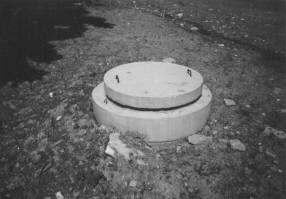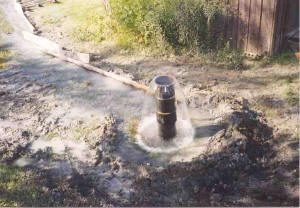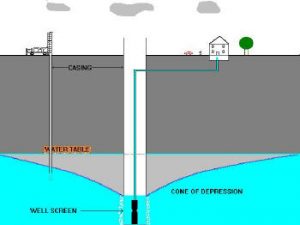FAQ
Frequently Asked Questions
What is a well?
A well is simply a hole in the ground through which water is extracted from the earth! Water is extracted for industrial, agricultural, or domestic purposes. There are many types of wells.
- Dug Well (Synonymous with ‘Shallow Well’ or ‘Spring’)

- This is a well constructed using a backhoe or excavator of some sort which digs a hole in the ground (generally from 10 – 20ft deep). When a source of water is encountered, gravel is put in the bottom of the hole, well tiles (made of steel or cement) are installed and then earth is put back around the tiles. The tiles are usually 3 to 4 feet in diameter. This type of well utilizes water that is fairly close to the surface.
- Drilled Well or Bedrock Well

- This is a well constructed using a drilling rig designed to be able to penetrate hundreds of feet into the earth in search of water. The upper part of the well has steel casing lining the hole to prevent collapse of the sidewalls. The diameter of the well is usually 6 inches on domestic applications. This type of well utilizes water that has penetrated much deeper into the earth than in a ‘shallow well.’
- Gravel Screened Well

- This is a well constructed using a drilling rig which installs a well screen (slotted piece of pipe) into a saturated gravel formation in order to extract water without getting a lot of sediment from the formation. The diameter of the well can range from 4 inches to 6 or 8 inches for domestic applications.
How much water do I need?
For normal Household use, you should have:
| DEPTH | FLOW |
|---|---|
| 6 GPM | at 100ft |
| 4 GPM | at 200ft |
| 2.5 GPM | at 300ft |
| 1 GPM | at 400ft |
| 0.5 GPM | at 500ft |
Individual situations will ultimately dictate what is required.
How long will it take?
A normal well takes anywhere from a few hours to a few days to drill. It is another day project to install a pumping system to get the water from the well to the house.
What type is for me?
Ordinarily, a drilled well is superior to a dug well. It is less likely to suffer pollution from surface contaminants or go dry during a period of no rainfall. A gravel screened well is also a preferable type of well compared to a dug well, however, it can only be installed if the necessary geologic conditions exist.
Where is the best place to drill?
Each state has regulations governing where on your property a well can be drilled. Generally, it has to be at least 100 feet from your leech field and 50 feet away from the septic tank. It should also be away from roads, driveways and buildings . It is impossible to predict where water will be found most economically.
How is a well priced?
Wells are usually drilled on a per foot basis. Thus, the deeper a well is, the more expensive it is.

